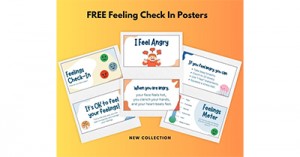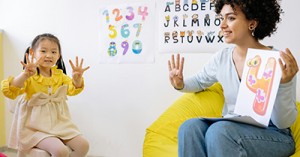Creating a supportive environment where children feel safe to express their emotions is crucial for their emotional and social development. The following article provides information for Strategies To Encourage Children To Express Emotions Activities For Toddlers and Preschoolers, Emotion Vocabulary, Activities to Build Emotion Vocabulary, Activities to Build Emotion Vocabulary, What To Do When A Child Is Angry, What To Do When A Child Is Being Violent/Aggressive, What To Do If A Child Hits You, Alternative Behaviours and more.
Strategies To Encourage Children To Express Emotions
- Model Open Expression: Show children how to express their own feelings by demonstrating it yourself. Use phrases like "I feel happy when..." or "I am sad because...".
-
Validate Their Emotions: Acknowledge and validate the child's feelings. Let them know that it’s okay to feel different emotions and that all feelings are valid.
-
Teach Emotional Vocabulary: Help children identify and name their emotions. Use visual aids like emotion charts or books that explore different feelings.
-
Role-Playing and Storytelling: Engage in role-playing games and storytelling that involve different emotional scenarios. This can help children practice expressing their emotions in a safe and controlled environment.
-
Encourage Art and Play: Art and play are powerful tools for children to express their emotions. Activities like drawing, painting, or playing with toys can provide an outlet for feelings that are hard to verbalize.
-
Create a Safe Space for Conversation: Set aside regular times for children to talk about their feelings. Let them know that it’s a judgment-free zone where they can share whatever they are experiencing.
-
Use Positive Reinforcement: Praise children when they express their emotions appropriately. This reinforces the behavior and encourages them to continue expressing their feelings in a healthy manner.
-
Develop Coping Strategies: Teach children simple coping mechanisms like deep breathing, counting to ten, or using a stress ball when they feel overwhelmed by their emotions.
- Visual Aids: Use emotion charts or flashcards with pictures of faces showing different emotions. Toddlers can point to the face that matches how they feel.
- Songs and Rhymes: Sing songs and recite rhymes about emotions. Music and rhythm can help toddlers connect with and express their feelings.
- Routine and Consistency: Ensure a consistent daily routine. Predictable routines help toddlers feel secure, which makes it easier for them to handle and express their emotions.
- Calm-Down Area: Create a quiet space with comforting items where toddlers can go to calm down when they are feeling overwhelmed. This can include soft toys, books, or a small tent.
- Positive Reinforcement: Praise toddlers when they express their emotions appropriately. For example, "You told me you were upset instead of throwing the toy. Good job!".
Activities For Toddlers
-
Emotion Faces: Use paper plates and markers to draw different facial expressions (happy, sad, angry, surprised). Let toddlers choose a face that matches their current emotion and talk about why they feel that way.
-
Emotion Charades: Play a simple version of charades where you act out different emotions and have the toddlers guess what emotion you're expressing. You can also let them take turns acting out emotions.
-
Feelings Collage: Provide magazines, scissors, and glue sticks. Let toddlers cut out pictures of faces that show different emotions and create a collage. Talk about each emotion as they glue the pictures onto the collage.
-
Emotion Stones: Paint stones with different facial expressions. Toddlers can use these stones to show how they are feeling. This can be a great tool for non-verbal expression.
-
Emotion Puppets: Use simple hand puppets or socks to create characters that display different emotions. Act out short scenarios with the puppets and discuss the emotions being shown.
-
Feelings Dice: Create a cube with different emotions on each side. Roll the dice and have the toddler show or talk about that emotion.
-
Mirror Play: Encourage toddlers to look at themselves in a mirror and make faces that show different emotions. This can help them become more aware of their own expressions.
-
Emotion Sorting: Have a variety of emotion cards and ask toddlers to sort them into categories like happy, sad, and angry. This activity can help them recognize and differentiate between emotions.
-
Feeling Bottles: Fill small plastic bottles with different materials to represent different emotions (e.g., glitter for happy, colored water for calm). Let toddlers shake the bottles and talk about what each bottle might represent.
-
Emotion Songs: Sing songs that talk about feelings, like "If You're Happy and You Know It." You can change the lyrics to include other emotions and actions.
Activities For Preschoolers
-
Emotion Vocabulary: Teach children the words for different emotions. Use simple and clear language to describe feelings such as happy, sad, angry, and scared.
-
Model Emotional Awareness: Demonstrate how to identify and talk about your own emotions. For example, say, "I feel excited because we're going to the park," or "I'm a little upset because I lost my keys."
-
Emotion Charts: Use charts or posters with pictures of faces showing different emotions. Children can point to the face that matches how they feel.
-
Books and Stories: Read books that explore different emotions. Discuss the characters' feelings and how they handle different situations.
-
Role-Playing: Engage in role-playing activities that involve different emotional scenarios. This helps children practice identifying and expressing their feelings in a safe and controlled environment.
-
Art and Play: Encourage children to express their feelings through art, such as drawing, painting, or playing with playdough. Sometimes, children can express their emotions better through creative activities.
-
Emotion Games: Play games that involve recognizing and naming emotions. For example, you can play "Emotion Charades," where children act out emotions and others guess what they are feeling.
-
Feelings Check-In: Have regular check-ins where children can share how they are feeling. Use a special toy or object to make the sharing time feel more special and comfortable.
-
Calm-Down Techniques: Teach simple techniques like deep breathing or counting to help children calm down when they are overwhelmed by their emotions.
-
Praise and Reinforcement: Acknowledge and praise children when they correctly identify and express their emotions. Positive reinforcement encourages them to continue using these skills.
Emotion Vocabulary
Building an emotion vocabulary is essential for children to effectively express and understand their feelings. Here are some key emotion words and phrases, along with activities to help children learn them:
Basic Emotions
-
Happy
-
Feeling joyful, glad, or content.
-
Example: "I feel happy when I play with my friends."
-
-
Sad
-
Feeling unhappy or sorrowful.
-
Example: "I feel sad when my toy breaks."
-
-
Angry
-
Feeling mad or upset.
-
Example: "I feel angry when someone takes my things without asking."
-
-
Scared
-
Feeling frightened or afraid.
-
Example: "I feel scared when there’s a loud noise."
-
-
Excited
-
Feeling very happy and eager.
-
Example: "I feel excited when we go on a trip."
-
-
Surprised
-
Feeling shocked or amazed.
-
Example: "I feel surprised when I get a gift."
-
Complex Emotions
-
Frustrated
-
Feeling annoyed or disappointed because something is not happening as expected.
-
Example: "I feel frustrated when I can’t solve a puzzle."
-
-
Proud
-
Feeling pleased with oneself or someone else’s achievements.
-
Example: "I feel proud when I finish my artwork."
-
-
Jealous
-
Feeling envious or wanting what someone else has.
-
Example: "I feel jealous when my friend gets a new toy."
-
-
Confused
-
Feeling unsure or puzzled.
-
Example: "I feel confused when I don’t understand the story."
-
Activities to Build Emotion Vocabulary
-
Emotion Flashcards
-
Create flashcards with pictures of faces showing different emotions and the corresponding words. Practice naming the emotions and using them in sentences.
-
-
Emotion Wheel
-
Make a wheel divided into sections, each with a different emotion. Children can spin the wheel and talk about a time they felt that emotion.
-
-
Feelings Matching Game
-
Create a matching game with cards that have pictures of faces and words for different emotions. Children can match the pictures to the words and discuss each emotion.
-
-
Emotion Stories
-
Read or create stories where characters experience various emotions. Pause to discuss what the characters are feeling and why.
-
-
Emotion Journals
-
Encourage children to keep a journal where they draw or write about their feelings each day. This helps them reflect on and articulate their emotions.
-
-
Role-Playing
-
Act out scenarios where different emotions might be felt. This helps children practice identifying and expressing their emotions in a safe environment.
-
Emotional Awareness
Emotional awareness is the ability to recognize and understand one's own emotions and the emotions of others. Developing emotional awareness in children is essential for their social and emotional well-being. Here are some strategies to foster emotional awareness:
Strategies for Developing Emotional Awareness
-
Teach Emotion Vocabulary: Help children learn the words for different emotions. This gives them the tools to express how they feel. Use visual aids like emotion charts and storybooks.
-
Model Emotional Awareness: Demonstrate how to recognize and talk about your own emotions. For example, say, "I feel proud because you shared your toys," or "I feel frustrated when I can't find my keys."
-
Mindfulness Activities: Engage children in mindfulness exercises like deep breathing or guided imagery. These activities help them become more aware of their internal states and emotions.
-
Reflective Questions: Ask children questions that prompt them to think about their feelings. For example, "How did you feel when your friend shared their snack with you?" or "What made you feel happy today?"
-
Emotion Check-Ins: Regularly check in with children about their feelings. Use a feelings chart or simply ask them to describe how they're feeling at different times of the day.
-
Role-Playing: Create role-playing scenarios that involve different emotions. This helps children practice identifying and expressing their feelings in a safe environment.
-
Art and Creativity: Encourage children to express their emotions through art, music, or dance. Creative activities provide an outlet for feelings that might be hard to verbalize.
-
Positive Reinforcement: Praise children when they accurately identify and express their emotions. This reinforces their efforts and encourages them to continue developing their emotional awareness.
Activities to Promote Emotional Awareness
-
Emotion Wheels: Create a wheel divided into sections with different emotions. Children can spin the wheel and share a time they felt that emotion.
-
Feeling Faces: Use paper plates or printouts to make faces showing different emotions. Children can use these to describe how they feel.
-
Emotion Stories: Read stories that explore emotions and discuss the characters' feelings. Ask children how they would feel in similar situations.
-
Calm-Down Bottles: Make bottles filled with glitter and water. Children can shake them and watch the glitter settle as a way to calm down and reflect on their feelings.
-
Emotion Sorting: Have children sort emotion cards into categories like happy, sad, and angry. Discuss each emotion as they sort the cards.
-
Mindfulness Jar: Create a mindfulness jar with slips of paper containing different emotions. Children can pull out a slip and talk about a time they felt that emotion.
What To Do When A Child Is Angry
Dealing with an angry child requires patience, empathy, and effective strategies. Here are some steps you can take to help a child manage their anger:
-
Stay Calm: Your calm demeanor can help de-escalate the situation. Take deep breaths and remain composed to set a positive example for the child.
-
Validate Feelings: Acknowledge the child's anger without judgment. Use phrases like, "I can see you're really upset" or "It's okay to feel angry sometimes."
-
Encourage Expression: Encourage the child to talk about what made them angry. Help them put their feelings into words, which can often reduce the intensity of their anger.
-
Set Boundaries: While validating their feelings, make it clear that certain behaviors are unacceptable (e.g., hitting, yelling). Teach them appropriate ways to express their anger.
-
Use Calm-Down Techniques: Teach the child simple techniques to calm down, such as deep breathing, counting to ten, or finding a quiet space to relax.
-
Provide Alternatives: Offer acceptable ways for the child to release their anger, such as squeezing a stress ball, drawing their feelings, or engaging in physical activity like jumping or running.
-
Problem-Solve Together: Once the child is calm, discuss what triggered their anger and brainstorm possible solutions together. This helps them feel heard and empowered.
-
Model Healthy Anger Management: Demonstrate how you manage your own anger in a healthy way. Children learn a lot by observing adult behavior.
-
Teach Emotional Vocabulary: Help the child develop a vocabulary for their emotions. Use specific words like "frustrated," "disappointed," or "upset" to help them better identify and express their feelings.
-
Use Positive Reinforcement: Praise the child when they handle their anger appropriately. Positive reinforcement encourages them to continue using these strategies.
-
Create a Calm-Down Kit: Put together a kit with items that help the child calm down, such as coloring books, fidget toys, or soothing music. This gives them a go-to resource when they're feeling angry.
-
Seek Professional Help if Needed: If a child's anger is frequent or severe, consider seeking help from a child psychologist or counselor. Professional guidance can provide additional strategies and support.
What To Do When A Child Is Being Violent/Aggressive
Handling a child's violent or aggressive behavior requires a calm and structured approach. Here are some steps to manage and address such behavior effectively:
-
Stay Calm: Your calm demeanor can help de-escalate the situation. Take deep breaths and remain composed to set a positive example for the child.
-
Ensure Safety: Make sure everyone is safe. If necessary, gently separate the child from others to prevent harm.
-
Acknowledge Feelings: Validate the child's emotions without condoning the behavior. Use phrases like, "I see you're very upset," to show understanding.
-
Set Clear Boundaries: Clearly state that aggressive behavior is not acceptable. Use simple and firm language, such as, "We do not hit. Hitting hurts."
-
Teach Alternative Behaviors: Show the child appropriate ways to express their feelings. For example, teach them to use words to express anger or frustration instead of physical actions.
-
Use Calm-Down Techniques: Encourage the child to use calming strategies like deep breathing, counting to ten, or going to a designated calm-down area.
-
Discuss the Incident: Once the child is calm, talk about what happened. Help them understand why their behavior was inappropriate and discuss better ways to handle similar situations in the future.
-
Model Positive Behavior: Demonstrate how to handle anger and frustration in a healthy way. Children learn a lot by observing adults.
-
Provide Positive Reinforcement: Praise the child when they handle their emotions appropriately. Positive reinforcement encourages them to continue using these strategies.
What To Do If A Child Hits You
If a child hits you, it's important to handle the situation calmly and constructively. Here are some steps to take:
-
Stay Calm: Take a deep breath and remain composed. Your calm reaction can help de-escalate the situation.
-
Ensure Safety: Make sure that both you and the child are safe. If necessary, gently move the child away from others to prevent further harm.
-
Acknowledge Feelings: Validate the child's emotions without condoning the behavior. For example, say, "I see you're very upset, but hitting is not okay."
-
Set Clear Boundaries: Clearly state that hitting is unacceptable. Use simple and firm language, such as, "We do not hit. Hitting hurts."
-
Teach Alternative Behaviors: Show the child appropriate ways to express their feelings. Encourage them to use words to express anger or frustration instead of physical actions.
-
Use Calm-Down Techniques: Encourage the child to use calming strategies like deep breathing, counting to ten, or going to a designated calm-down area.
-
Discuss the Incident: Once the child is calm, talk about what happened. Help them understand why their behavior was inappropriate and discuss better ways to handle similar situations in the future.
-
Model Positive Behavior: Demonstrate how to handle anger and frustration in a healthy way. Children learn a lot by observing adults.
-
Provide Positive Reinforcement: Praise the child when they handle their emotions appropriately. Positive reinforcement encourages them to continue using these strategies.
Alternative Behaviours
Teaching children alternative behaviors to manage their emotions constructively is key to their social and emotional development. Here are some strategies and activities to help guide them:
-
Use Words to Express Feelings: Encourage children to verbalize their emotions instead of acting out physically. For example, teach them to say, "I feel angry because..." or "I'm upset because..."
-
Take a Break: Teach children that it's okay to step away from a situation that is causing them distress. A designated "calm-down" space can be helpful.
-
Deep Breathing: Teach simple deep-breathing exercises. For example, "breathe in like you're smelling a flower, and breathe out like you're blowing out a candle."
-
Counting to Ten: Encourage children to count slowly to ten when they feel overwhelmed by their emotions. This can give them time to calm down before reacting.
-
Physical Activity: Channel their energy into physical activities like jumping, running, or dancing. This can help release pent-up emotions in a healthy way.
-
Use a Stress Ball: Provide a stress ball or other fidget toy that children can squeeze when they feel upset.
-
Draw or Write: Encourage children to draw pictures or write about their feelings. Sometimes expressing emotions through art or writing can be easier than verbalizing them.
-
Talk to a Trusted Adult: Teach children that they can always talk to a trusted adult when they are feeling strong emotions. Knowing they have support can be very comforting.
Activities to Reinforce Alternative Behaviours
-
Emotion Charades: Play a game where children act out emotions and guess what each one is. Discuss appropriate ways to express each emotion.
-
Calm-Down Kits: Create kits with items like coloring books, stress balls, and calming music. Use these kits when children need to take a break and calm down.
-
Role-Playing Scenarios: Set up role-playing scenarios that involve different emotional situations. Practice using words and alternative behaviors to handle those situations.
-
Emotion Drawing: Have children draw pictures of themselves feeling different emotions and talk about what they can do when they feel that way.
-
Mindfulness Activities: Incorporate mindfulness exercises like guided imagery or yoga into your daily routine. These activities can help children learn to manage their emotions.
-
Positive Reinforcement Chart: Create a chart where children can earn stickers or rewards for using alternative behaviors. Positive reinforcement encourages them to continue these practices.
-
Story Time Discussions: Read stories that involve characters experiencing various emotions. Pause to discuss how the characters handle their feelings and what they could have done differently.
Children's Books That Explore Emotions
-
"Where the Wild Things Are" by Maurice Sendak: A classic story about a boy named Max who goes on an imaginative journey to an island inhabited by wild creatures.
-
"The Very Hungry Caterpillar" by Eric Carle: A beautifully illustrated book that follows the journey of a caterpillar as it eats its way through various foods before transforming into a butterfly.
-
"The Giving Tree" by Shel Silverstein: A touching story about the relationship between a boy and a tree that gives him everything it has.
-
"Green Eggs and Ham" by Dr. Seuss: A fun and rhyming book that encourages children to try new things and not be afraid of change.
-
"Goodnight Moon" by Margaret Wise Brown: A soothing bedtime story that helps children wind down and prepare for sleep.
-
"Charlotte’s Web" by E.B. White: A heartwarming tale about the friendship between a pig named Wilbur and a spider named Charlotte.
-
"The Cat in the Hat" by Dr. Seuss: An entertaining story about a mischievous cat who brings chaos and fun to the lives of two children.
-
"Where the Sidewalk Ends" by Shel Silverstein: A collection of humorous and whimsical poems that explore various emotions and experiences.
-
"If You Give a Mouse a Cookie" by Laura Joffe Numeroff: A delightful story about the chain of events that occur when a boy gives a mouse a cookie.
-
"Love You Forever" by Robert Munsch: A touching story about the enduring love between a mother and her son.
Further Reading
Teaching Children About Emotions
Linking Social/Emotional Development To EYLF 0 - 5 Years
Understanding Temperament In Children
Supporting Toddlers With Challenging Behaviour
Strategies To Comfort A Crying Toddler
Strategies To Support The Mental Health Of Toddlers
Meditation For Preschoolers
Supporting Children's Self-Regulation
The Zones Of Regulation
Anger Management In Children
Strategies To Support Children To Say Sorry Meaningfully
Promoting Empathy In Children
All Feelings Are Welcome Posters
Feelings Posters
Feelings Flashcards







 As an Educator in Australia, your pay rate falls under the Children’s Services Award 2010. This award states the minimum amount that an employer can
As an Educator in Australia, your pay rate falls under the Children’s Services Award 2010. This award states the minimum amount that an employer can When working as a qualified Early Childhood Teacher (with a university degree) within a service, your rate of pay will come from the Educational Services
When working as a qualified Early Childhood Teacher (with a university degree) within a service, your rate of pay will come from the Educational Services When working as a Diploma Qualified Educator your pay rate is from the Children's Services Award 2010. This Award states your minimum rate of pay
When working as a Diploma Qualified Educator your pay rate is from the Children's Services Award 2010. This Award states your minimum rate of pay When working as a Cert 3 Qualified Educator, your pay rate is from the Children's Services Award 2010. This Award states your minimum rate of
When working as a Cert 3 Qualified Educator, your pay rate is from the Children's Services Award 2010. This Award states your minimum rate of Educational Leaders play a crucial role in their early childhood service by ensuring that the educational program aligns with best practices and supports the holistic
Educational Leaders play a crucial role in their early childhood service by ensuring that the educational program aligns with best practices and supports the holistic In early childhood education and care, ratios are more than a technicality—they are a frontline safeguard. Every child deserves responsive supervision, emotional connection, and developmental
In early childhood education and care, ratios are more than a technicality—they are a frontline safeguard. Every child deserves responsive supervision, emotional connection, and developmental Here’s a comprehensive Mobile Phone and Smart Watch Policy tailored for early childhood education and care (ECEC) services in Australia, aligned with the latest 2025
Here’s a comprehensive Mobile Phone and Smart Watch Policy tailored for early childhood education and care (ECEC) services in Australia, aligned with the latest 2025 With the new national child safety reforms kicking in on 1 September 2025, early childhood services like yours have a real opportunity to lead the
With the new national child safety reforms kicking in on 1 September 2025, early childhood services like yours have a real opportunity to lead the The Sea of Fish Challenge is a national initiative that invites children, educators, families, and communities to create and display fish artworks as a symbol
The Sea of Fish Challenge is a national initiative that invites children, educators, families, and communities to create and display fish artworks as a symbol Across the early childhood education and care sector, educators are sounding the alarm: current staffing ratios are insufficient to deliver safe, meaningful, and developmentally appropriate
Across the early childhood education and care sector, educators are sounding the alarm: current staffing ratios are insufficient to deliver safe, meaningful, and developmentally appropriate


